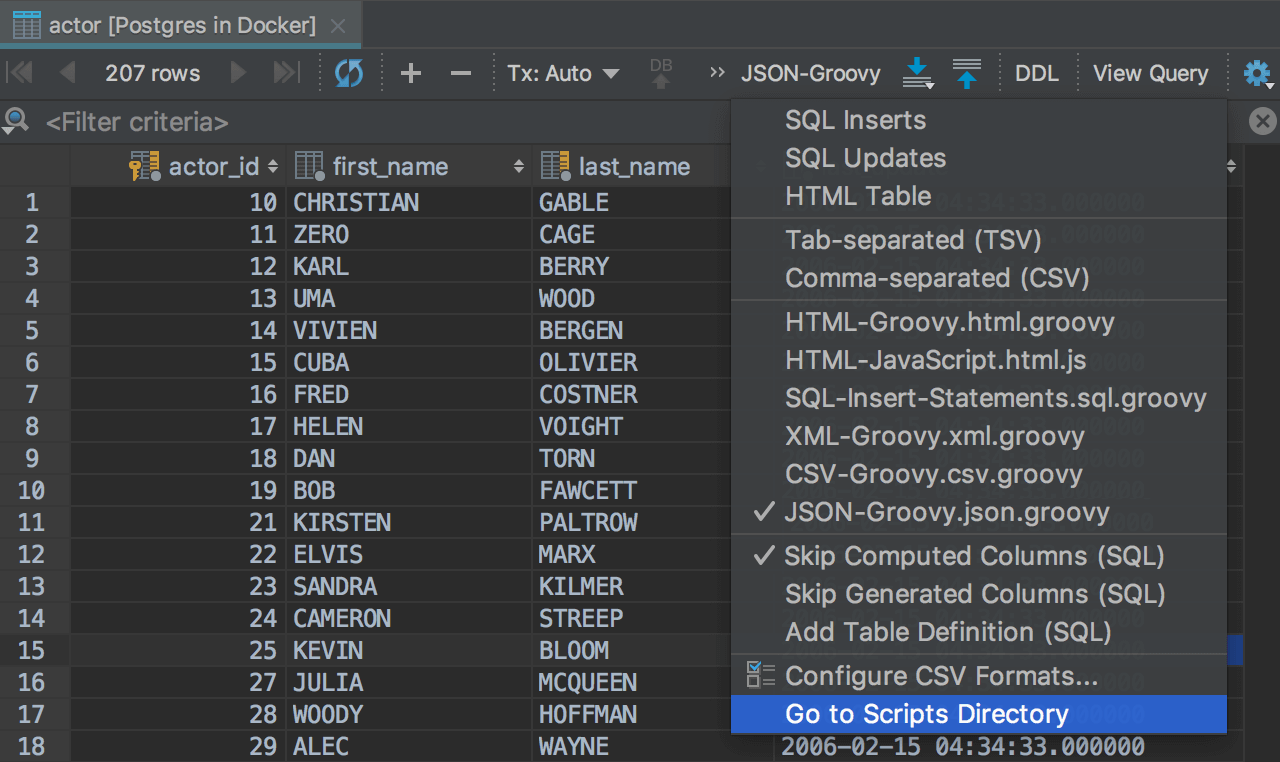

CSV format is very helpful if you want to exchange data between two different applications.Usually, when you run a query, you receive results in a table format. Each statement appears in a separate tab in the Services tool window. For example, if you have two SELECT statements in the query, you will see two tabs in the tool window. The Services tool window includes a list of consoles that are grouped according to a connection session to a data source. Open a new tab for each queryīy default, DataGrip updates the same tab with results each time you run a query. You can change this behavior and create a tab each time you run a query. In the IDE settings Ctrl+Alt+S, go to Database | Query Execution.

Select the Open results in new tab checkbox and click OK.Ĭlick the In-Editor Results button to view result sets one above another. You can define a tab title in the comment section before the query. In the Treat text as title after field, you can reserve a combination of symbols or characters after which any text will be treated as a tab title. By default, no combination is used, so any text after - or /* is treated as a tab title. Open settings by pressing Ctrl+Alt+S, navigate to Database | Query Execution | Output and Results. In the Treat text as title after field, define a combination for tab titles. To disable this feature, open settings Ctrl+Alt+S, navigate to Database | Query Execution | Output and Results, and clear the Create title for results from comment before query checkbox.įor more examples of custom titles for tabs, see Name the result tabs at. In the result set, click a cell value that you want to edit. To submit changes to a database, click the Submit icon ( ), or press Ctrl+Enter. To export data to a file, perform one of the following actions: Like in the data editor, you can edit values in the result set, auto-commit changes, delete rows, search text, and navigate through data. Right-click a result set, a table, or a view, select Export Data. Right-click a query and select Export Data to &File.

On the toolbar, click the Export Data icon ( ) and select Export to File. In the Export Data dialog, click Export to File. Select data in the result set or in the editor and press Ctrl+C. On the toolbar, click the Export Data icon ( ) and select Copy To Clipboard. Note that when this option is selected, performance will be reduced.Run queries to tables that you want to compare. TRACKDATAROWS should be limited to a range of 30 000 rows. You select TRACKDATAROWS on the Maintain/Configuration/General - Server Preferences tab. We recommend using this option only when designing and testing the import specification, and using the server preference TRACKDATAROWS. Include Transformation Information - Select this option if you want to include the transformation information when using the Track Data option. If selected, you will have the choice to either exclude (or include) transformation information. Track Data - Select this option to use the External Data Tracking log reports available in the 'Log Reports' window: More Information (from the Controller help file): When the system is in production, please remember to untick 'Track Data'.It is recommended that you only use 'track data' when designing/testing an import specification.This IBM Technote specifically relates to the scenario where the cause is that the customer has forgotten to untick the box 'Track Data' (after using it during development/testing phase). TIP: For more examples, see separate IBM Technote #1686200.There are other possible causes for slow performance when importing data.


 0 kommentar(er)
0 kommentar(er)
